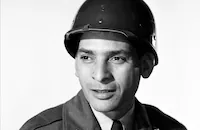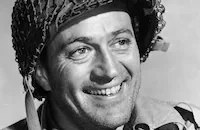Take the High Ground!

Brief Synopsis
Cast & Crew
Richard Brooks
Maurice Jara
Robert Arthur
William Hairston
Jerome Courtland
Steve Forrest
Film Details
Technical Specs

Synopsis
In May 1953, a new group of Army recruits at Fort Bliss in El Paso, Texas encounter their drill instructors, Sgt. Laverne Holt and the tough young Sgt. Thorne Ryan. After Ryan's caustic appraisal of the recruits, Holt vows to make soldiers out of them during the sixteen weeks of basic training. Ryan, a combat veteran who resents his stateside duty, repeatedly applies for a transfer back to the Korean front. One night, the men cross the border to Mexico for recreation. In a bar, Ryan and Holt see a beautiful woman, Julie Mollison, buying drinks for a group of soldiers. Later that evening, the two sergeants escort the inebriated Julie to her apartment, and Ryan finds himself drawn to her. Training resumes, and Ryan exposes his men to tear gas to prepare them for the harsh conditions of battle. Ryan and Holt return to the bar one night, and find Julie sitting alone. When the crude Sgt. Vince Opperman insults Julie, she runs out of the bar in tears, and Holt comforts her. Ryan and Opperman fight, and Opperman reveals that Julie was married to a soldier who was killed in Korea shortly after she left him. One day, recruit Lobo Naglaski visits the camp chaplain to confess his murderous feelings toward Ryan, but comes to see that the sergeant has very little time in which to do a tough job. Tensions arise between Ryan and Holt, both over Ryan's callous treatment of the men and Holt's relationship with Julie. Ryan puts his men through increasingly tough drills, and during a bitter confrontation one day, Holt slugs Ryan and walks away. Later, Ryan calls on Julie at her apartment, and they fall into a passionate embrace. When she resists his further advances, however, Ryan becomes insulting, casting aspersions on Julie's virtue and chiding her for having left her late husband. One day, during a field exercise, recruit Donald Quentin Dover IV runs away. Ryan tracks him down and gives the young man a second chance, confessing that his own father had been a deserter. As the training period draws to a close, Ryan returns to Julie's apartment and discovers she has moved out. He finds Julie and Holt at the train station. After Holt leaves, Ryan apologizes for his earlier behavior and asks Julie to marry him, but she sadly replies that he is married to the Army. Outside the train station, Ryan and Holt silently make their peace. The men finish basic training, and as the new soldiers march by during their graduation exercises, Ryan proudly points them out to a fresh group of recruits.

Director

Richard Brooks
Cast

Maurice Jara

Robert Arthur
William Hairston

Jerome Courtland

Steve Forrest

Carleton Carpenter

Russ Tamblyn

Elaine Stewart

Karl Malden

Richard Widmark
Chris Warfield
Bert Freed
Dabbs Greer

Gordon Jones
Lester Dorr
Vernon Rich
Tom Quinn
Jack Gargan
Harry Stanton
Creighton Hale
Joe Dominguez
Nacho Galindo

Iris Adrian

Don Haggerty
Steve Mitchell
Robert B. Williams
John Close
Mickey Contreras

Regis Toomey
Clarence Straight
Charlita
Harry Hines
Guy Wilkerson
Colette Mcmahon
Wilson Wood
Matilda Caldwell
Bill Foster
Richard Landry
Tommy Walker
Mickey Mccardle
William B. Lee

Acquanetta
Crew
Jack Aldworth
John Alton
John Dunning
Alvord Eiseman
Fred Faust
Cedric Gibbons
Herman Hoffman
Conrad Kahn
Lee Katz
Millard Kaufman
Lt. Charles Minor
Dore Schary
Frank Scheid
Douglas Shearer
Maj. Walter K. Sims U.s.a.
Alfred E. Spencer
Nipo T. Strongheart
Jerry Thorpe
Dimitri Tiomkin
Dimitri Tiomkin
William Tuttle
Ned Washington
Edwin B. Willis
Charles Wolcott

Photo Collections
Videos
Movie Clip


Film Details
Technical Specs

Award Nominations
Best Writing, Screenplay
Articles
Take the High Ground
Widmark, who was born to play this kind of role, is Sgt. Thorne Ryan, a hard-as-nails taskmaster who realizes he has a limited amount of time to whip a bunch of raw recruits (including West Side Story's (1961) Russ Tamblyn) into the kind of shape necessary to survive the rigors of combat. There's often a good cop/bad cop situation in these pictures, so Karl Malden plays the benevolent Sgt. Holt. The sergeant is more responsive to the men as human beings than Ryan is, and he even confronts his hardened fellow officer about it. But he still understands that the hard-ass tactics are necessary. Throw in what the soldiers' wives have to endure while their loved ones are training for war, and there's more than enough discord to go around.
The recruits, as you might expect, are a cross-section of stereotypes: there's "Tex" (Jerome Courtland) from Texas, an African-American (William Hairston) from the inner city, an overtly cowardly recruit (Robert Arthur) who finally manages to shape up, etc. But director Richard Brooks orchestrates their conflicts by focusing on their shared humanity. In that sense, the stereotypes are shattered to reveal something far more powerful than what you might expect. Brooks' care with character construction places Take the High Ground several notches above the usual war movie.
Brooks was already something of an old movie-making hand at this point, and he learned the ropes from one the greats. He broke into the film industry by writing stories and scripts for the legendary producer, Mark Hellinger. Brooks' work on such tough Hellinger films as The Killers (1946), The Naked City (1948), and Brute Force (1947) are as hard-hitting as they come.
Even after leaving Hellinger, he continued to film testosterone-driven pictures in a frank, declamatory style that eventually led to his gripping, pseudo-documentary adaptation of Truman Capote's novel, In Cold Blood (1967). He claimed the best piece of filmmaking advice he ever got came courtesy of John Huston, who directed Brooks' script for Key Largo (1948). Huston's advice? "Get to the point." And that's what he did, throughout his long, celebrated career.
Director: Richard Brooks
Producer: Dore Schary
Screenplay: Millard Kaufman
Editor: John Dunning
Cinematographer: John Alton
Art Direction: Cedric Gibbons, Edward Carfagno
Music: Dimitri Tiomkin
Principal Cast: Richard Widmark (Sgt. Ryan), Karl Malden (Sgt. Holt), Elaine Stewart (Julie Mollison), Russ Tamblyn (Paul Jamison), Carleton Carpenter (Merton Tolliver), Steve Forrest (Lobo Naglaski), Jerome Courtland (Elvin Carey)
C-102m. Closed captioning.
by Paul Tatara

Take the High Ground
Quotes
Trivia
Notes
The working title of this film was The Making of a Marine. The opening credits were preceded by a title reading "Korea May, 1951" and a brief scene depicting the character "Sgt. Thorne Ryan" in combat. The opening credits also acknowledge the "thousands of fighting men at Fort Bliss" and contain the following written prologue: "An Infantryman once said, 'There was a time I wanted to kill my drill sergeant, but later in combat I thanked God for what he taught me. I found out that a drill sergeant, tough as he was, wasn't as tough as the enemy.'" The closing credits, which differ in order from the opening credits, appear over footage of each of the principal actors. The order of cast members in the opening credits is as follows: Richard Widmark, Karl Malden, Elaine Stewart, Carleton Carpenter and Russ Tamblyn.
According to a December 7, 1953 article in Life, producer Dore Schary was first inspired to make a film about military training after reading a photo essay in the October 8, 1951 issue of Life titled "How to Make Marines." The article, which featured eight pages of photographs shot by Mark Kauffman, documented boat Platoon 268 throughout eight weeks of training at Parris Island. (Mark Kauffman's relationship to Take the High Ground screenwriter Millard Kaufman is undetermined.)
The film was originally to be shot at the U.S. Marine boot camp in San Diego, CA, according to an May 8, 1952 Hollywood Reporter news item. The December 1953 Life article asserts that "the Marines refused to cooperate because they did not want to stir up old controversies over the toughness of their training program." The Army, however, cooperated fully with the studio, and location filming took place at Fort Bliss in El Paso, TX. According to pre-production Hollywood Reporter news items, James Arness, Ralph Meeker, James Whitmore, Keefe Brasselle, William Campbell, Richard Anderson, Horace McMahon, Russ Saunders and Dick Morris were cast, but they were not in the film. Hollywood Reporter news items include Dean Miller, Fritz Apking, William Coughlin, Guy Way, Ray Saunders, Fred Shellack and George Rubotham in the cast, but their appearance in the final film cannot be confirmed. Take the High Ground! was nominated for an Academy Award for Best Story and Screenplay.














